The Acer Swift 3 SF314 Notebook Review: Swift Gets Swifter With Ryzen 4000
by Brett Howse & Andrei Frumusanu on May 5, 2020 8:00 AM ESTDisplay Analysis
Acer offers just a single display option on the 14-inch AMD based Swift 3, which is a 1920x1080 IPS display. Considering the price, this is the right option, although it is interesting that they are offering a 13.5-inch 3:2 Intel based Swift 3 in the SF313-52. The 3:2 works quite well for productivity, although less-so for gaming where 16:9 generally suffers from fewer issues.
There is no touch capability with this display, which is a bit of a shame, but also understandable with the other features offered. Acer did well to hit their target price range, and they made overall good decisions on where to invest. Touch is a nice to have, but not a necessity, although when you are used to having it, it is amazing how often you try to touch the screen.
To see how the display stacks up, the laptop was tested with Portrait Display’s CalMAN software suite. For brightness and contrast, the X-Rite i1Display Pro colorimeter was used, and for color accuracy readings the X-Rite i1Pro 2 spectrophotometer was employed.
Brightness and Contrast
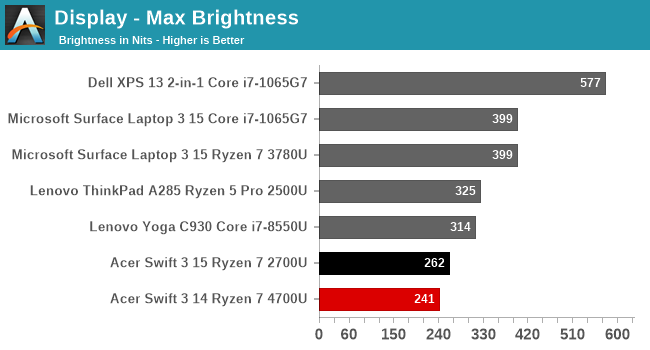
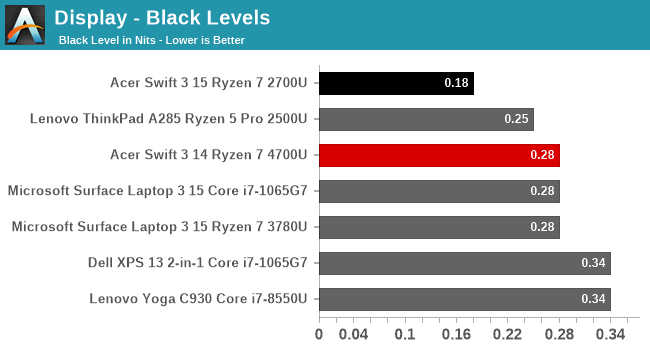
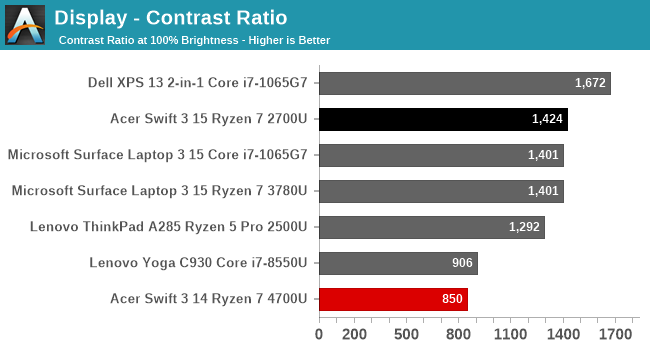
The Acer Swift 3 does not get off to a great start. In a budget notebook, displays tend to be one of the first things on the chopping block. Luckily, we’ve moved past the era where these types of notebooks would offer 1366x768 TN panels, but Acer’s 1920x1080 IPS choice doesn’t offer very good black levels, and their backlight is somewhat weak. It is an inauspicious start.
Grayscale

Grayscale measures the laptops ability to display white levels, from 0% (black) to 100% (white), and the Swift 3 performs quite poorly here. The blue levels are far too strong across most of the range. Gamma is also way off of the expected 2.2 level.
Gamut
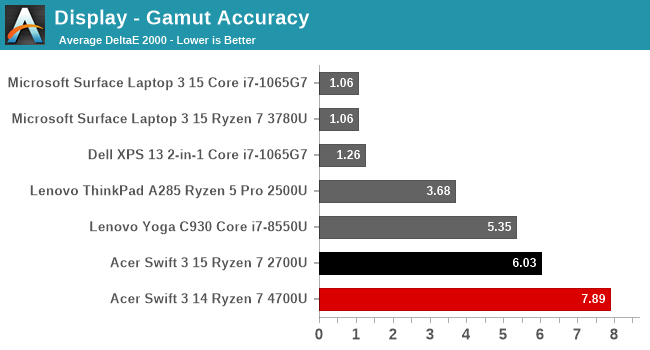
Windows 10 is still an sRGB system first and foremost, so proper sRGB gamut support is required for proper color accuracy. The Acer Swift 3 unfortunately does not cover anywhere near the sRGB gamut, which means that the LED backlighting was likely another area where some money was saved. Although grayscale can be salvaged with some ICC profiles, without full sRGB backlighting this laptop would likely suffer further if an ICC was applied because it simply cannot cover the entire sRGB spectrum.
Saturation
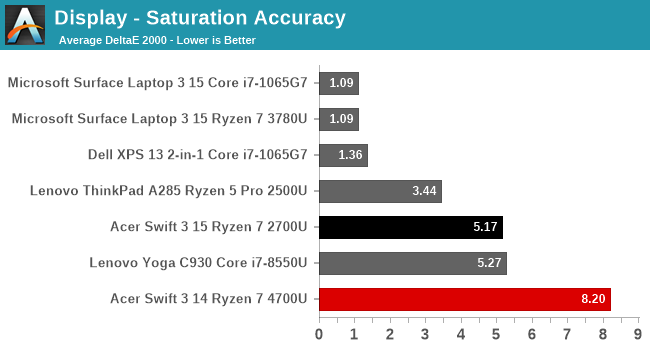
The saturation test covers the primary and secondary colors, but unlike the gamut where they are just measured at 100% level, we test them on 4-bit steps from 0% to 100%. Since we’ve already determined the laptop can’t hit the full sRGB gamut, it is no surprise to see the saturation sweeps suffer.
Gretag Macbeth
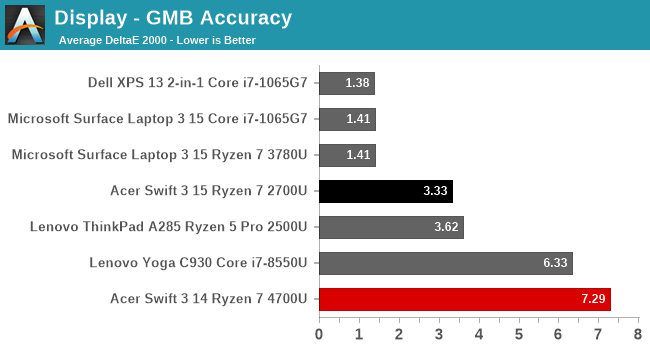
The Gretag Macbeth tests colors off of the primary and secondary axis, including the important skin tones, but with a display that can’t reproduce the entire sRGB range, the Acer Swift 3 naturally performs quite poorly on this test.
Colorchecker
Finally, we have the colorchecker, where you can more easily visualize the color errors with this display. This is a relative test, since any errors in your own display will influence the result, but on the bottom of the swatches is the color requested, and the top shows the color produced by the display. It is not pretty.
Display Conclusion
Overall, despite the poor showing here, the display is in-line with expectations at this price point. Over the last couple of years, there has been a push for better displays, and laptop makers have made the jump to 1920x1080 IPS panels pretty much across the board; so even though this display is poor compared to better IPS-based laptops, it still does offer the good viewing angles an IPS panel enjoys, and 1920x1080 works very well on a 14-inch screen size.
The very poor backlighting really does hamper the capabilities of this notebook. If you wanted to use it for editing photos or video, the internal components like the CPU, memory, and GPU, really would help, but the included display with its lack of sRGB coverage would certainly hinder the work. For basic office tasks, or even gaming, most people who are looking at a laptop at this price point will likely not be too concerned about the display, but just be aware that this one is deficient in several areas.
















191 Comments
View All Comments
Roland00Address - Monday, May 11, 2020 - link
MSRP prices are never rational, especially on commodities who often sell much less than their MSRP. While "branded / halo" items rarely deviate from their MSRPs.yeeeeman - Tuesday, May 5, 2020 - link
"and allows them to compete not just on performance, but battery life as well" - how it allows them to compete when we clearly see in the normalized test that they are 25% worse compared to Intel?yeeeeman - Tuesday, May 5, 2020 - link
Nevertheless, the implementation is disappointing since it cannot sustain a stable frequency, so gaming will be hard on this...I guess that 650$ price is not without of reason...Steve1992 - Tuesday, May 5, 2020 - link
The frequencies are fine: https://youtu.be/Xyns9jjEt5MSteve1992 - Tuesday, May 5, 2020 - link
Better example: https://youtu.be/pGgY-Aw2dZoneblogai - Tuesday, May 5, 2020 - link
They are OK, but could be better. iGPU can keep the frequences in CPU-light games, but drops them in CPU heavy games like Forza Horizon, Dota2, and especially Battlefield V multiplayer. Also, in case of GTA5 benchmark you posted- note that the video starts with APU at 25W, which is while APU is still boosting (several minutes). Then it goes to sustained power limit of 18W, and will stay there, with lower power and clocks.Flunk - Tuesday, May 5, 2020 - link
Low priced thin and lights with integrated graphics are all pretty much useless for gaming. It's not a reasonable or use case... at least according to notebook designers.DanNeely - Tuesday, May 5, 2020 - link
Gaming on a laptop with an IGP will never be a great experience because you either have to turn the quality settings down a lot or play older/less graphically complex titles; but that doesn't mean people don't do it. There's no easy way to get a desktop/mobile split, but ~10% of systems in the Steam HW Survey use some Intel GPU; I suspect a majority of them are laptops because it's where you're stuck with the IGP and can't slap in even a cheap discrete GPU for faster speeds.The GPU here isn't a 200W discrete card, or even a 40W discrete card; but it is a step above Intel's IGPs. That makes it an attractive option for someone who wants to be able to game on a laptop without spending a lot more and sacrificing profitability.
I do it some of the time when away from home on an old XPS13 with a i7-6xxx. It's a limited experience, especially after this many years, but is still better than mobile gaming on my phone.
philehidiot - Tuesday, May 5, 2020 - link
It has always been the case that if you want a decent gaming laptop, you're paying big bucks. I think the pricing here is pretty damned awesome. I'd never buy a laptop like this for gaming. It's that simple. The Vega GPU is kinda nice to have but integrated graphics are simply not meant for decent gaming. It's that simple. If you're looking at this and thinking "ooh gaming machine", you need to recalibrate your expectations.neblogai - Tuesday, May 5, 2020 - link
Well, gaming does not have to be the latest AAA specifically. Majority of best games will run on this integrated Vega very well. Most E-sports are also playble. And even a lot of best latest AAA will run well enough to experience and enjoy the game (if the game has to offer more than just graphics).